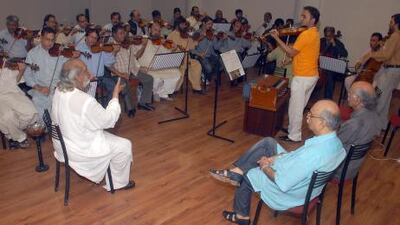Jazz Interpretations of Jazz
Standards and Bossa Nova
(Sachal Music)
????
Rarely do the words "interpretations" and "jazz" appear together on an album title without causing grimaces and a slow shuffle towards the exit. Images spring to mind of lengthy elevator journeys, painful hours spent listening to hold music and other situations where eardrums are held hostage to the jazzy butchering of popular classics, sometimes on panpipes.
Interesting then, that this flagrant bridger of such words has caused such a stir.
Music: The National listens
Last Updated: 20 June, 2011 UAE
Music reviews, festivals and all things sound related
In fact, the Sachal Studios Orchestra recently found its interpretations in the unlikely position atop the iTunes Jazz Chart. The 60-strong orchestra made the recording on the outskirts of Lahore, as part of a project by Izzat Majeed, a millionaire based in London. And its unusual take on jazz classics, blending sitars, tablas and other south Asian instruments together with sweeping strings and pianos has won over numerous fans.
Much of the attention has been drawn to the album's opening track, Take Five. Starting with the frighteningly fast-paced roll of a tabla, you'd be forgiven for thinking the recording had been made at the wrong speed. But when the sitar springs into action for the song's iconic 5/4 melody, all becomes clear. Such is the sound of the sitar, twisting and bending the notes in an almost playful manner, you might wonder why the instrument hasn't been used more in jazz.
Take Five has seen countless interpretations since it was first played in 1959, but Dave Brubeck, whose quartet made the song its own, has called Sachal Studio's version "the most interesting" he's ever heard, something that no doubt boosted album sales.
Take Five might provide the explosive, head-turning start, but the rest of the album takes a somewhat less frantic path. The classic bossa nova Desafinado sees vocals mixed in with strings and the sitar's unique wobblings. Samba de Verao, which has featured in everything from The Simpsons to Austin Powers and has been recorded by more than 180 artists across the world, gets perhaps its most unusual rendition, with a sitar and accordion competing for the main melody line.
Another bossa standard, The Girl from Ipanema, arguably avoids as much Asian influence as the others, only the rolling tablas in the background offering a geographical hint. Bacharach's This Guy's in Love With You begins with some rather steady piano chords before the metallic plucks of the sitar take over the main vocal melody. After a while, you'll probably forget how unusual it is for a sitar to be featured in jazz performances at all.
Naturally, the sudden rise of the Sachal Studios Orchestra has led to numerous comparisons, with the explosion of Cuba's jazz scene after the emergence of Buena Vista Social Club being perhaps the closest. Like their Caribbean counterparts, much of Sachal Studios Orchestra comprises older musicians who perhaps thought their toe-tapping days were numbered. But whether this album breathes life into Pakistan's music industry remains to be seen.
For the moment though, with news of a documentary on the way and performances planned for the US and UK, let's just sit back and enjoy a unique and enjoyably unusual slice of jazz. The novelty may eventually wear off, but this album is a worthy addition to any collection, and thankfully, a far cry from anything involving elevators and panpipes.

